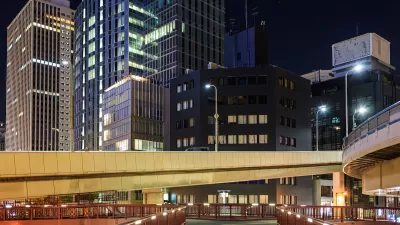A formula for the ideal office-to-housing candidate.

On the heels of a New York Times story by Emily Badger and Larry Buchanan explaining the complicated puzzles involved in converting office buildings to housing, Nate Berg, writing in Fast Company, describes the formula for an office building that can be successfully converted: “Typically, they’re mid-rise, modestly sized structures built before World War II, with at least two sides fronting open areas or streets in neighborhoods near, but not directly in, the city’s dense financial center.”
Architect and structural engineer Charles F. Bloszies analyzed San Francisco office buildings and found dozens of potential conversions that “make sense both economically and structurally.” The analysis follows the principle highlighted by Badger and Buchanan: that a residential building requires access to light and air for all units, features common in the pre-war buildings described above, those found in what Bloszies describes as the ‘Goldilocks zone.’ Unlike modern high-rise offices with sealed windows and little light exposure, “Bloszies’s analysis found that there are many structures that don’t have those issues, mostly four- or five-story prewar buildings that have operable windows and nestle into neighborhoods instead of towering above them.”
Berg adds that “The kind of analysis Bloszies undertook could be done with public information in nearly any city. Savvy developers, project-ready architects, or even proactive city planners could quickly identify office buildings in this Goldilocks zone and either start pursuing projects or fast-track the zoning changes that could help them take shape.” A future as housing may not be in the cards for all former office buildings, but some could also serve as data centers, logistics facilities, or other non-residential uses.
FULL STORY: Too big? Too small? No, these office buildings are just right for housing

Planetizen Federal Action Tracker
A weekly monitor of how Trump’s orders and actions are impacting planners and planning in America.

Maui's Vacation Rental Debate Turns Ugly
Verbal attacks, misinformation campaigns and fistfights plague a high-stakes debate to convert thousands of vacation rentals into long-term housing.

San Francisco Suspends Traffic Calming Amidst Record Deaths
Citing “a challenging fiscal landscape,” the city will cease the program on the heels of 42 traffic deaths, including 24 pedestrians.

Amtrak Rolls Out New Orleans to Alabama “Mardi Gras” Train
The new service will operate morning and evening departures between Mobile and New Orleans.

The Subversive Car-Free Guide to Trump's Great American Road Trip
Car-free ways to access Chicagoland’s best tourist attractions.

San Antonio and Austin are Fusing Into one Massive Megaregion
The region spanning the two central Texas cities is growing fast, posing challenges for local infrastructure and water supplies.
Urban Design for Planners 1: Software Tools
This six-course series explores essential urban design concepts using open source software and equips planners with the tools they need to participate fully in the urban design process.
Planning for Universal Design
Learn the tools for implementing Universal Design in planning regulations.
Heyer Gruel & Associates PA
JM Goldson LLC
Custer County Colorado
City of Camden Redevelopment Agency
City of Astoria
Transportation Research & Education Center (TREC) at Portland State University
Jefferson Parish Government
Camden Redevelopment Agency
City of Claremont





























